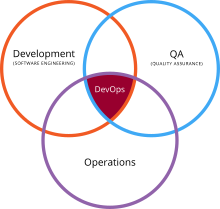DevOps promotes a set of processes and methods for thinking about communication and collaboration between development, QA, and IT operations. It aims at establishing a culture and environment where building,
testing, and releasing software, can happen rapidly, frequently, and more reliably.
Tools such as Docker and Jenkins have automated more quality assurance processes and releases by development team. Puppet and automated configuration tools like Vagrant have also been used and frequently referenced in DevOps.
The specific goals of a DevOps approach span the entire delivery
pipeline. They include improved deployment frequency, which can lead to
faster time to market, lower failure rate of new releases, shortened
lead time between fixes, and faster mean time to recovery in the event
of a new release crashing or otherwise disabling the current system.
DevOps aims to maximize the predictability, efficiency, security, and
maintainability of operational processes. Very often, automation
supports this objective. DevOps integration targets product delivery, continuous testing, quality testing, feature development, and maintenance releases in order to improve reliability and security and provide faster development and deployment cycles.
Companies with very frequent releases may require a DevOps awareness or orientation program. Daily deployment cycle would be much higher at organizations producing
multi-focus or multi-function applications. This is referred to as
continuous deployment.
- Use of agile and other development processes and methodologies
- Demand for an increased rate of production releases from application and business unit stakeholders
- Wide availability of virtualized and cloud infrastructure from internal and external providers
- Increased usage of data center automation and configuration management tools
- Increased focus on test automation and continuous integration methods
- A critical mass of publicly available best practices

Thank you for your article it looks good and providing some valuable information.
ReplyDeleteRegards,
DevOps Training in Hyderabad
I just loved your article on the beginners guide to starting a blog.If somebody take this blog article seriously in their life, he/she can earn his living by doing blogging.thank you for thizs article. devops online training
ReplyDelete